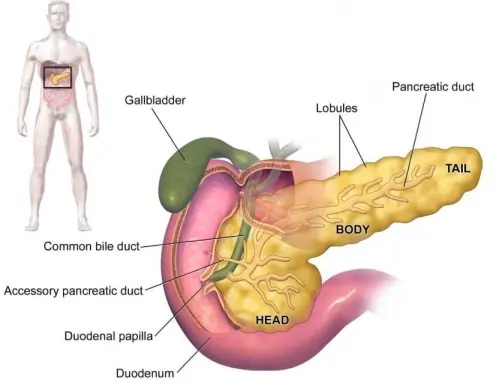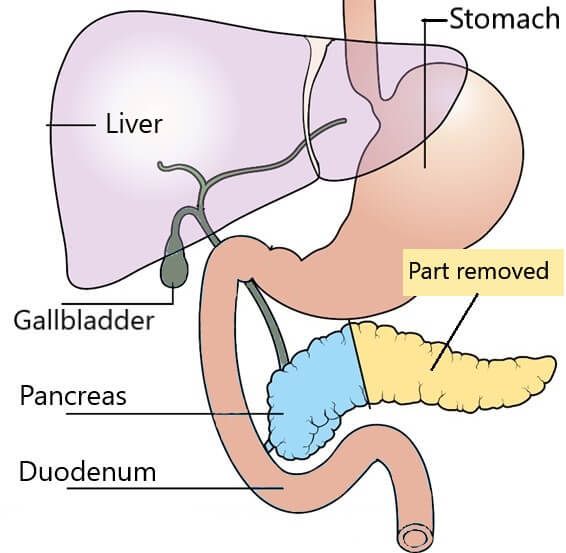SURGERY FOR TUMOURS OF BODY AND TAIL OF PANCREAS

Pancreas is a soft gland in the back of the upper part of the abdomen, behind the stomach. It makes enzymes for digestion of food and various hormones, predominantly for control of sugar. For description, the pancreas is divided into head, neck, body and tail.
There is a thin tube coursing through the whole of the pancreas, it is called the pancreatic duct. The duct carries digestive enzymes from the pancreas and drains into the upper part of the intestine called the duodenum. Important blood vessels of the abdomen course through and around the pancreas. These include blood supply of the spleen, liver and the intestine.
Pancreatic lesions
Some cells in the pancreas may become cancerous and then grow and spread, this is called pancreatic cancer. Not only cancer but various other tumours and cysts afflict pancreas. These include serous cystadenoma, mucinous cystadenoma, neuroendocrine tumours, intraductal papillary mucinous neoplasm (IPMN) and solid pseudopapillary neoplasm of the pancreas. Their treatment depends on the type of lesion and stage in which they are detected and may require surgical removal.
Surgery
These lesions can occur anywhere in the pancreas from head to tail. If they are not locally advanced and has not spread to distant organs such as liver or lung, they are removed along with the involved part of the pancreas.
The surgery to remove the head of the pancreas is called Whipple procedure or pancreaticoduodenectomy. The surgery to remove the body and tail of the pancreas is called distal pancreatectomy. The spleen is an organ involved in filtering of blood and immunity and it lies close to the tail of the pancreas. The blood supply of spleen courses close to body and tail of the pancreas. Many times spleen also needs to be removed along with body and tail of pancreas called distal pancreatosplenectomy or pancreaticosplenectomy.
Despite Removal of body and tail of pancreas usually enough of pancreas remains for digestion and making hormones.
DISTAL PANCREATECTOMY OR PANCREATOSPLENECTOMY

Distal pancreatectomy
A distal pancreatectomy is a surgery to remove the body and tail of pancreas including the tumour. In this surgery, the pancreas and pancreatic duct are divided at neck or body depending upon the location of the tumour. The cut end of the pancreas is either sutured closed or stapled close. The spleen is removed if the tumour involves splenic vessels or if lymph nodes need to be cleared in advanced tumours, termed pancreatosplenectomy. In distal pancreatosplenectomy, the blood supply of the spleen, which is through splenic artery and vein is cut. The spleen is then mobilised and removed along with the pancreas.
In spleen preserving pancreatectomy the splenic artery and vein are preserved. The blood supply of the liver and intestine has to be meticulously preserved in either case. Before proceeding with surgery we ensure that cancer has not spread. If the tumour involves adjacent organs, such as stomach and colon, the part of the involved organ is also resected. A drainage tube is generally inserted to drain fluids from the operated area.
Recovery after distal pancreatectomy
Recovery after the surgery takes around three to five days. In extensive surgery for advanced or complicated tumours, the recovery might take longer. The drainage tube is watched for the content plus amount and removed when appropriate.
In a few patients, the recovery will not be smooth and there will be a deviation from the expected postoperative course. This is described as a complication. There can be bleeding, infection and intra-abdominal collection. The cut end of the pancreatic duct can leak, a condition identified as pancreatic fistula. Most of these complications are manageable but may result in prolongation of hospital stay.
At the time of discharge, most patients are eating a normal diet and can carry out activities of daily living. Depending on the type and stage of the tumour, you might be advised further chemotherapy or radiotherapy called adjuvant treatment. In the long term, some of the patients may develop indigestion due to pancreatic enzyme insufficiency or diabetes due to deficiency of hormones.
Laparoscopic distal pancreatectomy
In less advanced cases this operation is now done laparoscopically. In laparoscopic surgery, instead of long incision, the procedure is done through small holes made over the abdomen. Your abdomen is filled with gas to expand and fill it like a soft balloon. A long and slender camera is then inserted through one of these holes, which projects high-resolution images of the inside of the abdomen on a high definition monitor. Specially designed long thin instruments are placed inside the abdomen through rest of the ports to carry out the surgery.
Advantages of minimally invasive surgery
Laparoscopic distal pancreatectomy has many advantages. A long incision on your belly is avoided. Postoperative stress and pain are markedly decreased. The recovery from the operation is faster and consequently, the hospital stay is shorter. The overall complication rate is decreased. All this results in earlier return to home and work.
Wish you a speedy recovery!


